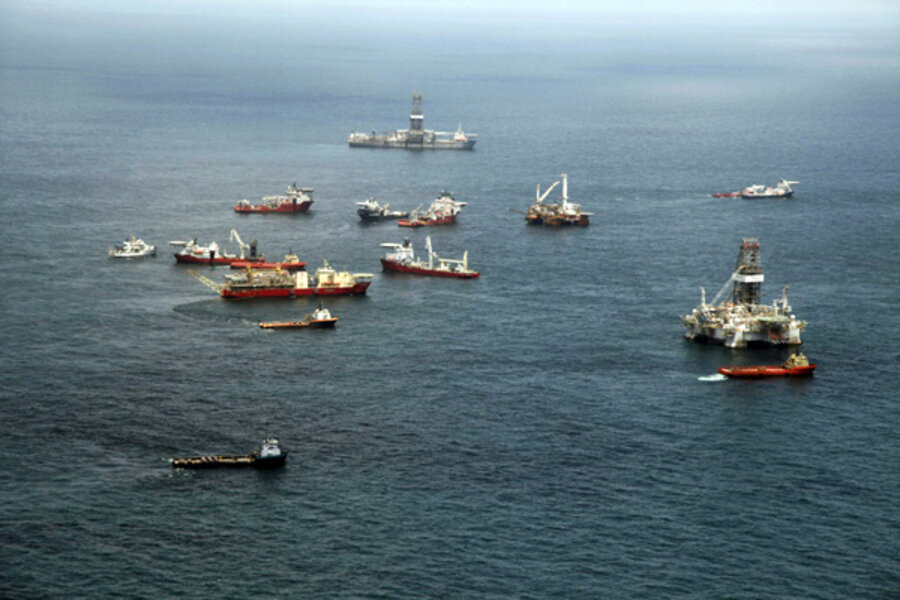Oil spill BP clean-up to stop due to churning tropical rainstorm
Loading...
| ON THE GULF OF MEXICO
Crew members aboard dozens of ships in the Gulf of Mexico prepared Thursday to evacuate as a tropical rainstorm brewing in the Caribbean brought the deep-sea effort to plug BP's ruptured oil well to a near standstill.
Though the rough weather was hundreds of miles from the spill site and wouldn't enter the Gulf for at least a few more days, officials ordered technicians trying to plug BP's well to stand down because they needed several days to clear the area, where about 65 ships are tending to the spill.
"It's a controlled chaos out there," Lt. Patrick Montgomery told an Associated Press reporter aboard the Coast Guard cutter Decisive heading to the spill site from Pascagoula, Miss.
IN PICTURES: Gulf oil spill's impact on nature
The cutter, with a 75-member crew, is the Coast Guard's primary search and rescue vessel and would be the last ship to leave in the event of an evacuation. It was within a few miles of the well site Thursday morning.
Just days before the expected completion of a relief well designed to permanently throttle the free-flowing crude, the government's spill chief said Wednesday that work was suspended.
Worse yet, retired Coast Guard Adm. Thad Allen said foul weather could require reopening the cap that has contained the oil for nearly a week, allowing oil to gush into the water again for days while engineers wait out the storm.
"This is necessarily going to be a judgment call," said Allen, who was waiting to see how the storm developed before deciding whether to order any of the ships and crews stationed some 50 miles (80 kilometers) out in the Gulf of Mexico to head for safety.
The cluster of thunderstorms passed over Haiti and the Dominican Republic on Wednesday, and forecasters said the system would probably move into the Gulf over the weekend. They gave it a 40 percent chance of becoming a tropical depression or a tropical storm by Friday.
Crews had planned to spend Wednesday and Thursday reinforcing with cement the last few feet of the relief tunnel that will be used to pump mud into the gusher and kill it once and for all. But BP put the task on hold and instead placed a temporary plug called a storm packer deep inside the tunnel, in case it has to be abandoned until the storm passes.
"What we didn't want to do is be in the middle of an operation and potentially put the relief well at some risk," BP vice president Kent Wells said.
If the work crews are evacuated, it could be two weeks before they can resume the effort to kill the well. That would upset BP's timetable, which called for finishing the relief tunnel by the end of July and plugging the blown-out well by early August.
Scientists have been scrutinizing underwater video and pressure data for days, trying to determine if the capped well is holding tight or in danger of rupturing and causing an even bigger disaster. If the storm prevents BP from monitoring the well, the cap may simply be reopened, allowing oil to spill into the water, Allen said.
BP and government scientists were meeting to discuss whether the cap could be monitored from shore.
As the storm drew closer, boat captains hired by BP for skimming duty were sent home and told they wouldn't be going back out for five or six days, said Tom Ard, president of the Orange Beach Fishing Association in Alabama.
In Florida, crews removed booms intended to protect waterways in the Panhandle from oil. High winds and storm surge could carry the booms into sensitive wetlands.
Also, Shell Oil began evacuating employees out in the Gulf.
Even if the storm does not hit the area directly, it could affect the effort to contain the oil and clean it up. Hurricane Alex stayed 500 miles (800 kilometers) away last month, yet skimming in Alabama, Mississippi and Florida was curtailed for nearly a week.
The relief tunnel extends about two miles under the seabed and is about 50 to 60 feet vertically and four feet horizontally from the ruptured well. BP plans to insert a final string of casing, or drilling pipe, cement it into place, and give it up to a week to set, before attempting to punch through to the blown-out well and kill it.
BP's broken well spewed somewhere between 94 million gallons (356 million liters) and 184 million gallons (697 million liters) into the Gulf before the cap was attached. The crisis — the biggest offshore oil spill in U.S. history — unfolded after the BP-leased Deepwater Horizon rig exploded April 20, killing 11 workers.
The cause of the blast is still under investigation, but there have been repeated questions raised by rig workers over the equipment and safety conditions aboard the rig.
RELATED:





